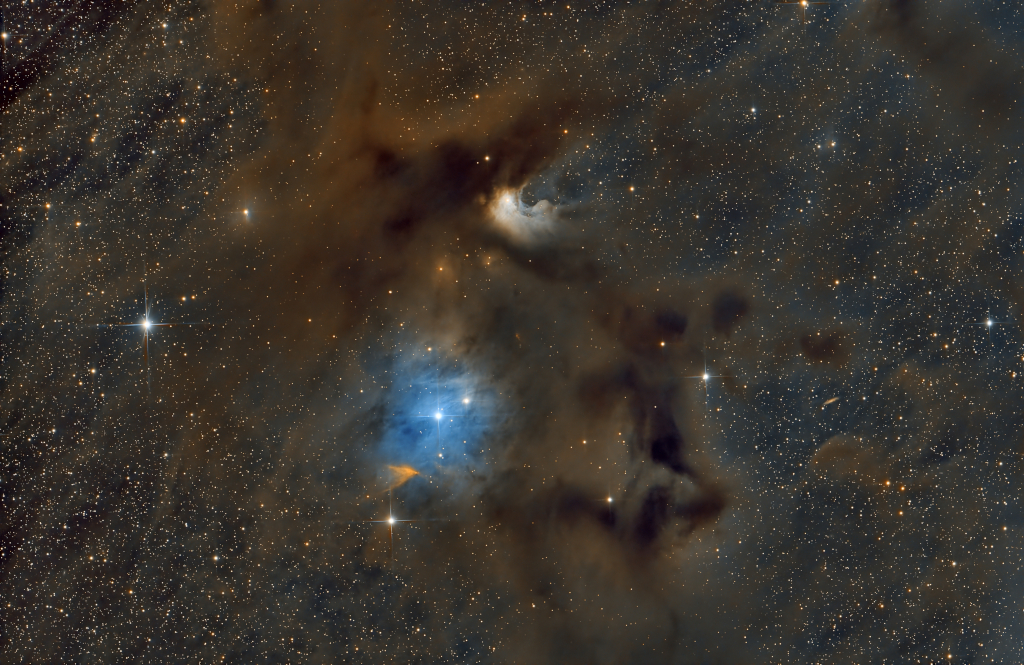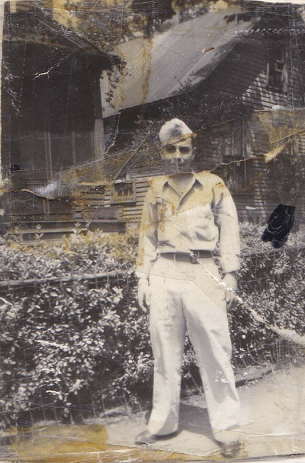Blog
Most eye-catching is the grand arch of the Milky Way Galaxy, the band that is the central disk of our galaxy which is straight but distorted by the wide-angle nature of this composite image. Many stars well in front of the Milk Way will be visible, with the bright white star just below the stellar arch being Altair, and the bright blue star above it being Vega. The air glows green on the left, just above the yellow cloud deck. The featured image was taken last month on Portugal‘s Madeira Island in the North Atlantic Ocean. Oh, and what happens after you reach the top of these stairs and admire the amazing sky is, quite probably, that you then descend down the stairs on the other side. 
Daniel Robert Elfman (born May 29, 1953 LA, CA) is an American film composer, singer, songwriter, and musician. He came to prominence as the lead singer and primary songwriter for the new wave band Oingo Boingo in the early 1980s. Since scoring his first studio film in 1985, Elfman has garnered international recognition for composing over 100 feature film scores, as well as compositions for television, stage productions, and the concert hall.
more...Freddie Redd (May 29, 1928 – March 17, 2021 Harlem, NY) was an American hard-bop pianist and composer. He is best known for writing music to accompany The Connection (1959), a play by Jack Gelber. According to Peter Watrous, writing in The New York Times: “Mr. Redd hung out at jam sessions in the 1950s and played with many of the major figures, Sonny Rollins to Art Blakey, and worked regularly with Charles Mingus. When things got tough, he just moved on, living in Guadalajara, Mexico, and in Paris and London.
more...Eugene Joseph Wright (May 29, 1923 – December 30, 2020 Chicago) was an American jazz bassist who was a member of the Dave Brubeck Quartet.
more...Dark markings and bright nebulae in this telescopic southern sky view are telltale signs of young stars and active star formation. They lie a mere 650 light-years away, at the boundary of the local bubble and the Chamaeleon molecular cloud complex. Regions with young stars identified as dusty reflection nebulae from the 1946 Cederblad catalog include the C-shaped Ced 110 just above and right of center, and bluish Ced 111 below it. Also a standout in the frame, the orange tinted V-shape of the Chamaeleon Infrared Nebula (Cha IRN) was carved by material streaming from a newly formed low-mass star. The well-composed image spans 1.5 degrees. That’s about 17 light-years at the estimated distance of the nearby Chamaeleon I molecular cloud.

Leland Bruce Sklar (born May 28, 1947) is an American bassist and session musician. He rose to prominence as a member of James Taylor‘s backing band, which coalesced into a group in its own right, The Section, which supported so many of Asylum Records‘ artists that they became known as Asylum’s de facto house band, as those artists became iconic singer-songwriters of the 1970s.
Sklar has recorded and toured with artists including James Taylor, Jackson Browne, Carole King, Linda Ronstadt, Phil Collins, Toto, The Doors and Lyle Lovett. As a group member, session player, or touring musician, Sklar has appeared on over 2,000 albums, and contributed to many motion picture and television show soundtracks. Since 2018, he has been the bassist for The Immediate Family, a group reuniting lifelong friends and most of his former bandmates from The Section.
Leland Bruce Sklar was born May 28, 1947, in Milwaukee, Wisconsin. His mother’s family was from Duluth, Minnesota. His father’s family was from Milwaukee. Originally, the paternal side of the family came from Odesa, Ukraine. Sklar is a Ukrainian surname meaning glazier, a person whose profession is fitting glass into windows and doors.
more...John Henry Creach (May 28, 1917 – February 22, 1994), better known as Papa John Creach, was an American blues violinist who also played classical, jazz, R&B, pop and acid rock music. Early in his career, he performed as a journeyman musician with Louis Armstrong, Fats Waller, Stuff Smith, Charlie Christian, Big Joe Turner, T-Bone Walker, Nat King Cole and Roy Milton.
Following his rediscovery by drummer Joey Covington in 1967, he fronted a variety of bands (including Zulu and Midnight Sun) in addition to playing with Jefferson Airplane, Hot Tuna, Jefferson Starship, the San Francisco All-Stars (1979–1984), Dinosaurs (1982–1989) and Steve Taylor.
Creach recorded a number of solo albums and guested at several Grateful Dead and Charlie Daniels Bandconcerts. He was a regular guest at the early annual Volunteer Jams, hosted by Charlie Daniels, which exposed him to a new audience that was receptive to fiddle players.
Creach was born in Beaver Falls, Pennsylvania. As a child, he was introduced to the violin by an uncle, and he received both tutoring in the instrument and conservatory training. Creach and his family moved to Chicago in 1935.
more...Aaron Thibeaux “T-Bone” Walker (May 28, 1910 – March 16, 1975) was an American blues musician, composer, songwriter and bandleader, who was a pioneer and innovator of the jump blues, West Coast blues, and electric blues sounds. In 2018 Rolling Stone magazine ranked him number 67 on its list of “The 100 Greatest Guitarists of All Time”.
Aaron Thibeaux Walker was born in Linden, Texas, of African-American and Cherokee descent. His parents, Movelia Jimerson and Rance Walker, were both musicians. His stepfather, Marco Washington (a member of the Dallas String Band), taught him to play the guitar, ukulele, banjo, violin, mandolin, and piano.
Walker began his career as a teenager in Dallas in the 1920s. His mother and stepfather were musicians, and Blind Lemon Jefferson, a family friend, sometimes came over for dinner. Walker left school at the age of 10, and by 15, he was a professional performer on the blues circuit. Initially, he was Jefferson’s protégé and would guide him around town for his gigs. In 1929, Walker made his recording debut with Columbia Records, billed as Oak Cliff T-Bone, releasing the single “Wichita Falls Blues” backed with “Trinity River Blues”. Oak Cliff is the community in which he lived at the time, and T-Bone is a corruption of his middle name. The pianist Douglas Fernell played accompaniment on the record.
more...Andrew Dewey Kirk (May 28, 1898 – December 11, 1992) was an American jazz bandleader and saxophonist who led the Twelve Clouds of Joy, a band popular during the swing era.
He was born in Newport, Kentucky, United States. Kirk grew up in Denver, Colorado, where he was tutored by Wilberforce Whiteman, Paul Whiteman‘s father. Kirk started his musical career playing with George Morrison’s band, but then went on to join Terrence Holder‘s Dark Clouds of Joy. In 1929, he was elected leader after Holder departed. Renaming the band Clouds of Joy, Kirk also relocated the band from Dallas, Texas, to Kansas City, Missouri. Although named the Clouds of Joy, the band has also been known as the Twelve Clouds of Joy due to the number of musicians in the band. They set up in the Pla-Mor Ballroom on the junction of 32nd and Main in Kansas City and made their first recording for Brunswick Records that same year. Mary Lou Williams came in as pianist at the last moment, but she impressed Brunswick’s Dave Kapp, so she became a member of the band.
more...Honoring my dad Mike Labriola today who suffered greatly serving the USA, his new country, moving from his homeland of Italy. Traumatized and grief stricken by the experience he persevered and made it back home.

more...
This week, an image of the broad and sweeping spiral galaxy NGC 4731 is the Hubble Picture of the Week. This galaxy lies among the galaxies of the Virgo cluster, in the constellation Virgo, and is located 43 million light-years from Earth. This highly detailed image was created using six different filters. The abundance of colour illustrates the galaxy’s billowing clouds of gas, dark dust bands, bright pink star-forming regions and, most obviously, the long, glowing bar with trailing arms.
Barred spiral galaxies outnumber both regular spirals and elliptical galaxies put together, numbering around 60% of all galaxies. The visible bar structure is a result of orbits of stars and gas in the galaxy lining up, forming a dense region that individual stars move in and out of over time. This is the same process that maintains a galaxy’s spiral arms, but it is somewhat more mysterious for bars: spiral galaxies seem to form bars in their centres as they mature, accounting for the large number of bars we see today, but can also lose them later on as the accumulated mass along the bar grows unstable. The orbital patterns and the gravitational interactions within a galaxy that sustain the bar also transport matter and energy into it, fuelling star formation. Indeed, the observing programme studying NGC 4731 seeks to investigate this flow of matter in galaxies.
Beyond the bar, the spiral arms of NGC 4731 stretch out far past the confines of this close-in Hubble view. The galaxy’s elongated arms are thought to result from gravitational interactions with other, nearby galaxies in the Virgo cluster.
[Image Description: A close-in view of a barred spiral galaxy. The bright, glowing bar crosses the centre of the galaxy, with spiral arms curving away from its ends and continuing out of view. It’s surrounded by bright patches of light where stars are forming, as well as dark lines of dust. The galaxy’s clouds of gas spread out from the arms and bar, giving way to a dark background with some foreground stars and small, distant galaxies.]

Niels-Henning Ørsted Pedersen (Danish pronunciation: [ne̝lsˈhene̝ŋ ˈɶɐ̯steð ˈpʰeðɐsn̩], 27 May 1946 – 19 April 2005), also known by his abbreviated nickname NHØP, was a Danish jazz double bassist.
Pedersen was born in Osted, near Roskilde, on the Danish island of Zealand, the son of a church organist. As a child, Ørsted Pedersen played piano, but from the age of 13, he started learning to play upright bassand at the age of 14, while studying, he began his professional jazz career in Denmark with his first band, Jazzkvintet 60 (Danish for Jazz Quintet 60). By the age of fifteen, he had the ability to accompany leading musicians at nightclubs, working regularly at Copenhagen’s Jazzhus Montmartre, after his debut there on New Year’s Eve 1961, when he was only 15. When seventeen, he had already turned down an offer to join the Count Basie orchestra, mainly because he was too young to get legal permission to live and work as a musician in the United States.
The Montmartre was a regular stop-off for touring American Jazz stars, and as a member of the house band, the young Ørsted Pedersen performed with saxophonists such as Booker Ervin, Sonny Rollins, Dexter Gordon, Rahsaan Roland Kirk and Stan Getz, and pianist Bill Evans, with whom he toured in Europe in 1965. During the 1960s, Pedersen played with a series of other important American jazzmen who were touring or resident in Denmark, including Ben Webster, Brew Moore, Bud Powell, Count Basie, Roy Eldridge, Dizzy Gillespie, Jackie McLean, and vocalist Ella Fitzgerald.
more...Dee Dee Bridgewater (née Denise Garrett, May 27, 1950) is an American jazz singer and actress. She is a three-time Grammy Award-winning singer-songwriter, as well as a Tony Award-winning stage actress. For 23 years, she was the host of National Public Radio’s syndicated radio show JazzSet with Dee Dee Bridgewater. She is a United Nations Goodwill Ambassador for the Food and Agriculture Organization.
Born Denise Eileen Garrett to an African American family in Memphis, Tennessee, she was raised Catholic in Flint, Michigan. Her father, Matthew Garrett, was a jazz trumpeter and teacher at Manassas High School, and through his playing, she was exposed to jazz early on. At the age of 16, she was a member of a Rock and R&B trio, singing in clubs in Michigan. At 18, she studied at Michigan State University before she went to the University of Illinois at Urbana-Champaign. With the school’s jazz band, she toured the Soviet Union in 1969.
The next year, she met trumpeter Cecil Bridgewater, and after their marriage, they moved to New York City, where Cecil played in Horace Silver‘s band. In the early 1970s, Bridgewater joined the Thad Jones-Mel Lewis Jazz Orchestra as lead vocalist. This marked the beginning of her jazz career, and she performed with many of the great jazz musicians of the time, such as Sonny Rollins, Dizzy Gillespie, Dexter Gordon, Max Roach, Rahsaan Roland Kirk, Wayne Garfield, and others. She performed at the Monterey Jazz Festival in 1973. In 1974, her first solo album, entitled Afro Blue, appeared, and she performed on Broadway in the musical The Wiz.[5] For her role as Glinda the Good Witch she won a Tony Award in 1975 as “Best Featured Actress”, and the musical also won the 1976 Grammy Award for Best Musical Show Album.
more...Clifford Everett “Bud” Shank Jr. (May 27, 1926 – April 2, 2009) was an American alto saxophonist and flautist. He rose to prominence in the early 1950s playing lead alto and flute in Stan Kenton‘s Innovations in Modern Music Orchestra and throughout the decade worked in various small jazz combos. He spent the 1960s as a first-call studio musician in Hollywood. In the 1970s and 1980s, he performed regularly with the L. A. Four. Shank ultimately abandoned the flute to focus exclusively on playing jazz on the alto saxophone. He also recorded on tenor and baritone sax. His most famous recording is probably the version of “Harlem Nocturne” used as the theme song in Mickey Spillane’s Mike Hammer. He is also well known for the alto flute solo on the song “California Dreamin’” recorded by The Mamas & the Papas in 1965.
Bud Shank was born in Dayton, Ohio, United States. He began playing the clarinet in Vandalia, Ohio, but switched to saxophone before attending the University of North Carolina. While at UNC, Shank was initiated into the Pi Kappa Alpha fraternity. In 1946, he worked with Charlie Barnet before moving on to Kenton and the West coast jazz scene. He also had a strong interest in what might now be termed world music, playing Brazilian-influenced jazz with Laurindo Almeida in 1953 and 1954. In 1958, he became the first American jazz musician to record in Italy, with an Italian jazz orchestra conducted by Ezio Leoni (aka Len Mercer), paving the way for Chet Baker and others who would follow Shank’s tracks recording in Milan with Maestro Leoni. In 1958 and 1960, Shank provided the soundtracks for two Bruce Brown surf movies: Slippery When Wet and Barefoot Adventure. His world music collaborations continued in 1962, fusing jazz with Indian traditions in collaboration with Indian composer and sitar player Ravi Shankar.
more...Kenny Dennis (born May 27, 1930) is a Philadelphia-born American jazz drummer. He has played on albums for Nancy Wilson, Sonny Stitt, Sonny Rollins, Johnny Griffin, Oscar Brown Jr., Charles Mingus, Billy Taylor, and Mal Waldron.
Dennis began his musical career in the United States Army Band, playing drums in three bands from 1948-1952. After being discharged, he connected with junior high school mate, pianist Ray Bryant and became part of The Ray Bryant Trio along with Jimmy Rowser on bass. They became the house trio at the North Philadelphia Jazz Club, Blue Note where they played for such jazz artists as Kai Winding, Chris Connor and Sonny Stitt. His career next took him to New York, where he worked with artists including Miles Davis, Phineas Newborn, Jr., Billy Taylor, Erroll Garner, Charles Mingus and Sonny Rollins.
In 1957, Dennis performed in Sonny Rollins’s Trio with bassist Wendell Marshall at Carnegie Hall—a historic performance that was commemorated in 2007 with a 50th anniversary concert. Dennis moved to California, when Miles Davis recommended him to Lena Horne. Recording credits include recordings with such artists as Michel Legrand, Miles Davis, Charlie Mingus, Nancy Wilson, Gerald Wilson and poet Langston Hughes.
Since 1997 he has been an assistant director of the Lab Band at the award winning Los Angeles County High School for the Arts. He and his wife Nancy Wilson were married from 1960 to 1970. Their son, Kacy (né Kenneth Dennis, Jr.) was born in 1963.
more...More Posts
- Grover Washington Jr.
- Dickey Betts
- Manu Dibango
- Toshiko Akiyoshi
- World Music with Hańba
- Daily Roots with Coco Tea
- Surviving the Pandemic and Realizing Racial Justice
- The Cosmos with NGC 6300
- McCoy Tyner
- Big Mama Thornton
- Pérez Prado
- Carlos Gardel
- Flamenco Fridays with Las Migas
- Daily Roots with the Cimarons
- Surviving the Pandemic and Realizing Racial Justice
- The Cosmos with Simeis 147
- Ismail “Pops” Mohamed
- Guitar Slim
- Bob Cranshaw
- Ray Nance